New 'Good Dino' trailer: Can Pixar duplicate success of 'Inside Out'?
With 'Inside Out' and now 'The Good Dinosaur,' Pixar is delivering double on its promise to produce one original film a year.

Pixar Animation Studios has barely finished riding the wave of success that was last month’s "Inside Out," and it is already gearing up for its next release: "The Good Dinosaur."
The trailer for "The Good Dinosaur" dropped Tuesday, and the film is slated to hit theaters in November – of this year, not next. Pixar has never premiered more than one film in a single year, making The Good Dinosaur the company’s first second film of the year.
What’s more, 2015 welcomes two original Pixar films – neither "Inside Out" nor "The Good Dinosaur" is a sequel, which is just what Pixar fans asked for, and just what the company promised.
Following the 2013 release of "Monsters, Inc." prequel "Monsters University," Pixar president Ed Catmull responded to complaints that Pixar’s last few years had been sequel-heavy. Mr. Catmull told Buzzfeed News the company was setting a goal to begin producing “one and a half” films annually: one original movie a year, and one sequel or prequel every other year.
“For artistic reasons … it’s really important that we do an original film a year,” Mr. Catmull said. “Every once in a while, we get a film where we want or people want to see something continuing in that world – which is the rationale behind the sequel. They want those characters, which means we were successful with them. But if you keep doing that, then you aren’t doing original films.”
"Inside Out" is the first film to come out since Catmull’s announcement. And with "The Good Dinosaur" on its heels, Pixar is already set to exceed its goal for originals. The next Pixar sequel, "Finding Dory," is scheduled for mid-2016, a full three years after "Monsters University."
While for Pixar fans, two new movies a year may at first sound like two Christmases a year, Pixar Times blogger Josh Spiegel warned in 2013 that if quantity begins to precede quality, Pixar may degenerate into what he sees as a DreamWorks Animation-like state: lots of movies, but few of note.
But even Mr. Spiegel countered his own pessimism, writing, “It may be easy to see the doom and gloom in the prospect of more Pixar movies in less time, but isn’t it just as much a dream finally achieved? … If we take Pixar at face value, though, the better question ... is this: why wouldn’t you be excited to see more than one Pixar movie a year?”

